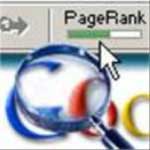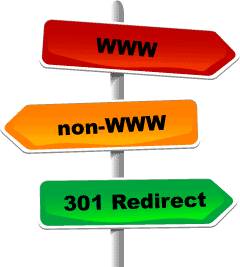Canonicalization: What on Earth is THAT?
An Inadvertent Problem May Be Hurting Your Rankings
This isn’t as hard to understand as it sounds. For simplicity, think of this as accidental duplicate pages on your web site. We’ll talk about how this happens to you, why you should care, and what to do about it.
What It Is
 The following URLs (web site addresses) all point to the same page:
The following URLs (web site addresses) all point to the same page:
- example.com
- www.example.com
- example.com/default.html
- www.example.com/default.html
These are alternate ways of addressing the home page on this web site. Search engines see these as separate addresses, even though they all point to the same content. Typically search engines will choose one they consider the primary address, but that may not be best for you. That’s canonicalization, and it can affect your rankings.
How It Happens
In the vast majority of cases, someone can get to your home page whether or not they use the “www” in front. Most people use the “www” but not everyone does. So it’s a good thing that both will take them to your home page. The problem is that unless your webmaster does something about it, those remain two distinct addresses. We’ll discuss later why that’s a bad thing.
Now, let’s talk about your home page file name.
In many web design programs, creating a link from one of your pages back to the home page appends the page name (for example /default.html) to your domain. People who get there that way may bookmark your home page, and the result is a technically different address from the one most people will use (without the page file name at the end). Again, we have multiple addresses for your home page.
How to Tell If It’s a Problem For You
In your web browser address bar enter your website address like this: www.example.com Then hit [Enter] to go to your home page. Look back at the address bar. Does it still show www.example.com? Just make a mental note.
Now go to your browser address bar and enter your website address without the “www” part like this: example.com. Again, hit [Enter] to go to your home page and take a look back at the address bar. Does it still show example.com?
If the address bar always shows the address just like you entered it, that’s a problem. If one of the addresses changes when you go to your home page, then you’re fine. In other words, if your address bar always shows your address with the “www” prefix even if you entered it without the “www”, that’s terrific. Or if your address bar always shows your address without the “www” prefix regardless of how you typed it in, that’s fine, too.
But if you can see it both ways depending on how you typed it in, your site suffers from a domain canonicalization problem. We’ve been alerting our readers to the “www” issue since 2005.
Now navigate to a couple of internal pages on your web site, then find the link to take you back to your home page.
In your browser’s address bar, do you see a page file name at the end? Or just your domain name? If there’s a page file name at the end, you suffer from a home page canonicalization problem.
Why Should You Care?
The main issue here has to do with your web site’s “reputation” which search engines measure by your link authority. We have seen on numerous occasions where a web site has its incoming links split 50-50 or 60-40 between the two addresses. Let’s say your site has 500 incoming links. If 200 point to example.com and 300 point to www.example.com, you won’t get the full benefit of your 500 incoming links. Your Google PageRank may reflect only 200 or 300 links.
And since links within your own web site also factor into your link popularity, any that point to your home page with the file name at the end (e.g., www.example.com/default.html) may not count in your favor either.
How Can You Fix It?
Fortunately, it’s not too difficult to fix.
There are two parts — fixing the more important issue – the domain canonicalization (“www”) issue, and fixing the appended file name issue.
Fixing the Domain Canonicalization Issue

RewriteEngine on
RewriteCond %{HTTP_HOST} ^example\.com
RewriteRule ^(.*)$ https://www.example.com/$1 [R=301,L]
If you’re hosted on a Windows server, your web designer will have to check for the proper way to do this.
Multiple Domain Names
Often business owners register multiple domains for their website. It may be a good idea to protect those names from being used by competitors, but if the content is the same at all of them, as it often is, you run into the same problems as just described. Fortunately, the solution is just as easy, substituting the appropriate domain names into the code above.
Fixing the Home Page Canonicalization Issue
This is simple, too. Simply make sure that every link on your site that points to your home page does so without any file name attachment, but simply points to it like www.example.com/. If you do that, no one is likely to end up on a page with an address like www.example.com/default.html. And since they won’t be at that address, any links they send to you won’t go there either.
Now, the Hard Part
Some eCommerce sites can encounter a more complex canonicalization issue.
 Google puts it this way: “Say you have a clothing site and one of your top items is a green dress. The product page for the dress may be accessible through several different URLs, especially if you use session IDs or other parameters.” For example:
Google puts it this way: “Say you have a clothing site and one of your top items is a green dress. The product page for the dress may be accessible through several different URLs, especially if you use session IDs or other parameters.” For example:
- http://www.example.com/products/women/dresses
- http://www.example.com/products?category=dresses&color=green&cruel=no
- http://example.com/shop/index.php?product_id=32&highlight=green+dress&cat_id=1&sessionid=123&affid=431>
- http://example.com/dresses/cocktail?gclid=ABCD
- http://www.example.com/dresses/greendress.html
According to Google, “To gain more control over how your URLs appear in search results, and to consolidate properties, such as link popularity, we recommend that you pick a canonical (preferred) URL as the preferred version of the page. You can indicate your preference to Google in a number of ways. We recommend them all, though none of them is required (if you don’t indicate a canonical URL, we’ll identify what we think is the best version).”
We think you should control this and not leave it up to Google. Fortunately, Google Webmaster Tools has instructions.
SEO Buddy has recently published an excellent article all about canonical tags; I recommend it if you’re interested in learning more.




There is a certain unity to this work that I really appreciate. Please keep creating this amazing content.
– concrete contractors buffalo ny
Such a great help! This is what I need since I don’t have any idea why my Bathroom Remodel Tacoma website ranking falls down.